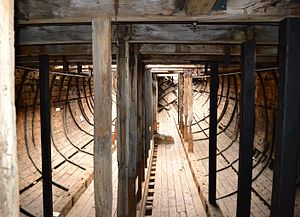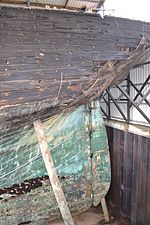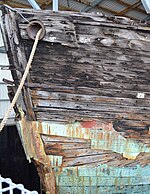Edwin Fox
 Interior of hull of Edwin Fox, on display at Picton, New Zealand
| |
| History | |
|---|---|
| Name | Edwin Fox |
| Owner |
|
| Port of registry | Southampton |
| Builder | William Henry Foster, Calcutta |
| In service |
|
| Out of service | 1950 |
| Fate | Sold, 1965 |
| Status | Museum ship |
| General characteristics (as built)[1] | |
| Type | East Indiaman |
| Tons burthen | 836 tons bm |
| Length | 157 ft (48 m) o/a |
| Beam | 29 ft 8 in (9.04 m) |
| Draught | 23 ft 6 in (7.16 m) |
| Sail plan | Full-rigged ship |
Edwin Fox is the world's second oldest surviving merchant sailing ship[2] and the only surviving ship that transported convicts to Australia. She is unique in that she is the "only intact hull of a wooden deepwater sailing ship built to British specifications surviving in the world outside the Falkland Islands".[3] Edwin Fox carried settlers to both Australia and New Zealand and carried troops in the Crimean War. The ship is dry-docked at The Edwin Fox Maritime Centre at Picton in New Zealand.
Early history

She was built of teak in Calcutta in 1853 and her maiden voyage was to London via the Cape of Good Hope. She then went into service in the Crimean War as a troop ship, and later carrying passengers and cargo.
On 14 February 1856 she began her first voyage to Melbourne, Australia, carrying passengers, then moved to trading between Chinese ports. In 1858 she was chartered by the British Government as a convict ship bound for Fremantle, Western Australia.
Emigrant ship
In 1867 she was converted from a full-rigged ship to a barque, and from 1873 served on the emigrant route to New Zealand, making four voyages carrying a total of 751 settlers to the distant new colony. Conditions on board for the four to six-month voyage were harsh and luggage strictly limited, and several voyagers did not survive to see their new home. On arrival they often found conditions much harsher than expected, and were also faced with being cut off from family and friends in distant Europe, sometimes for life.
Lamb and coal

Edwin Fox was overtaken by the age of steam, and in the 1880s she was refitted as a floating freezer hulk for the booming sheep industry in New Zealand. She was towed to Picton in the South Island on 12 January 1897 where she initially continued as a freezer ship, before being further dismembered in 1905 when converted into a coal store hulk. By this time she had long since lost her rigging and masts, and suffered holes cut in her sides and the removal of most fittings. The ship was in use until 1950, then abandoned to rot at her moorings.
Preservation

In 1965 she was bought by the Edwin Fox Society for the nominal sum of one shilling. In 1967 she was towed to Shakespeare Bay where she remained for the next 20 years. After much further fundraising the ship was refloated and towed to her final home, a dry dock on the Picton waterfront. She floated in and the dock was drained to begin restoration.
Initially it was planned to restore the ship completely, replacing rigging and refurbishing the interior. It has since been decided that this is not practical, not only for reasons of finance but because the timbers required are no longer available. She is thus preserved as a hull with an adjacent informative museum, and visitors can visit two of her decks and so stand inside this atmospheric piece of history. Most visitors to New Zealand will pass through Picton as they move between the islands, and so there are high hopes that the continual cost of her preservation can be met by revenue from the visitor centre. The trust are also looking for sponsors to continue their work on this unique vessel.
She has been given a category I registration from Heritage New Zealand.
See also
- Thomas Bushell, a convict transported on Edwin Fox
- Convict era of Western Australia
- List of convict ship voyages to Western Australia
- List of museum ships
References
Notes
- ^ "The 149 year Illustrated Log of the Edwin Fox". New Zealand Maritime Record. 2007. Retrieved 23 August 2013.
- ^ Excluding the abandoned and deteriorating wreck at Port Stanley of the barque Jhelum, built 1849. The American whaler Charles W. Morgan, built in 1841, is the oldest surviving merchant ship.
- ^ Norman J. Brouwer (1993) International Register of Historic Ships. p. 212. 2nd ed., World Ship Trust. Anthony Nelson, Shropshire, England. ISBN 0 904614 46 8
Bibliography
- Costley, Nigel (2014). Teak and Tide: The ebbs and eddies of the Edwin Fox - from the Ganges to Picton, New Zealand - the changing fortunes of the last surviving 19th century merchantman. Nelson: Nikau Press. ISBN 9780958289856.
External links
- Edwin Fox Maritime Centre
- "Edwin Fox Hull and Anchor Windlass". New Zealand Heritage List/Rārangi Kōrero. Heritage New Zealand.
- "The Edwin Fox, Picton, New Zealand" from H2G2
Template:Surviving ocean going ships 41°17′6″S 174°0′24″E / 41.28500°S 174.00667°E
